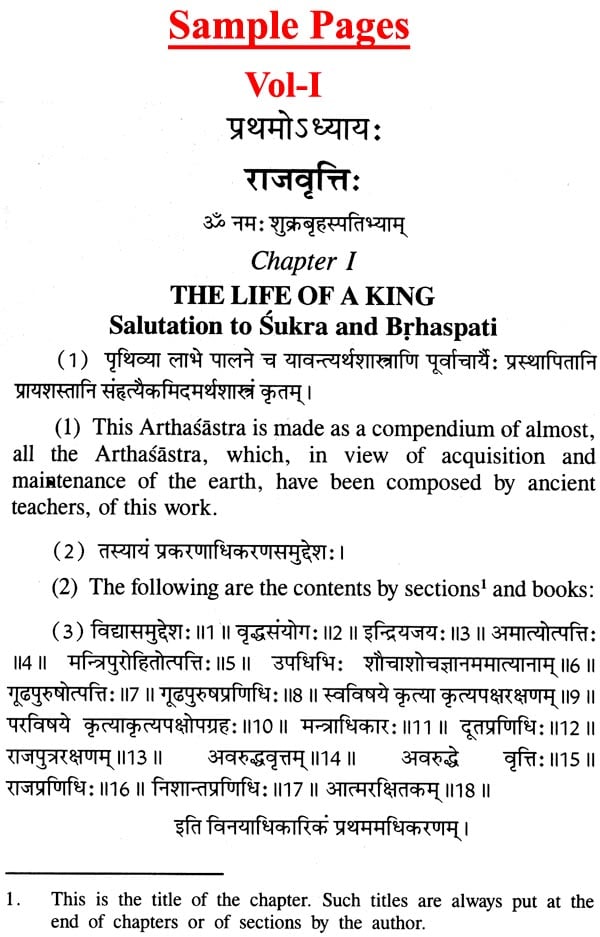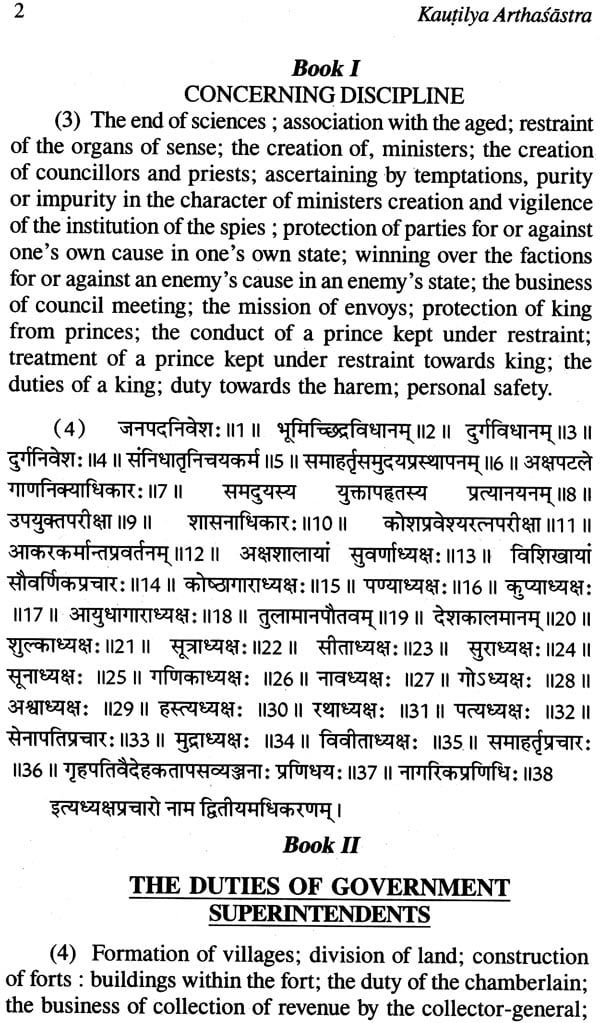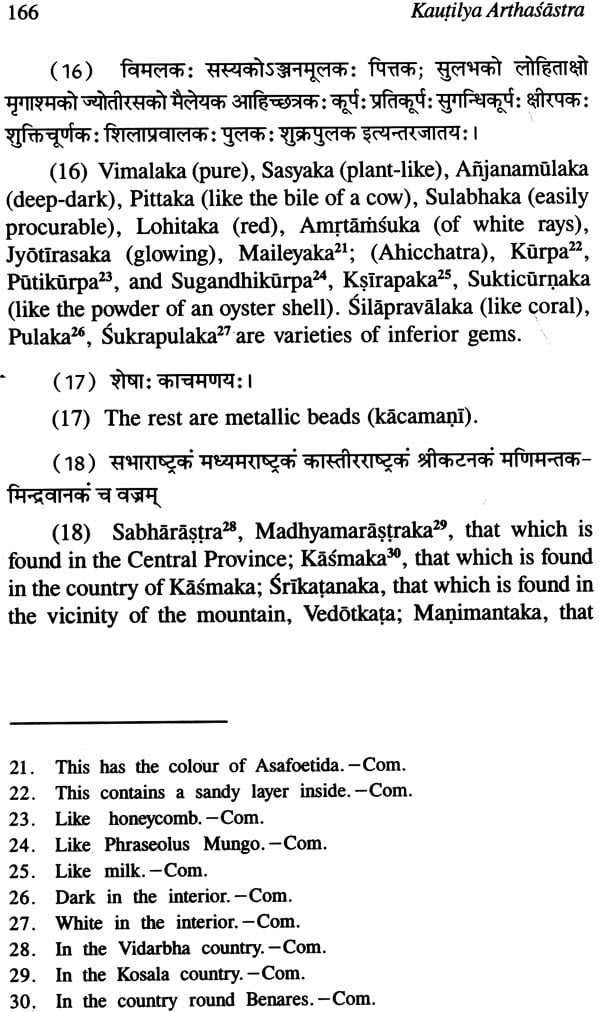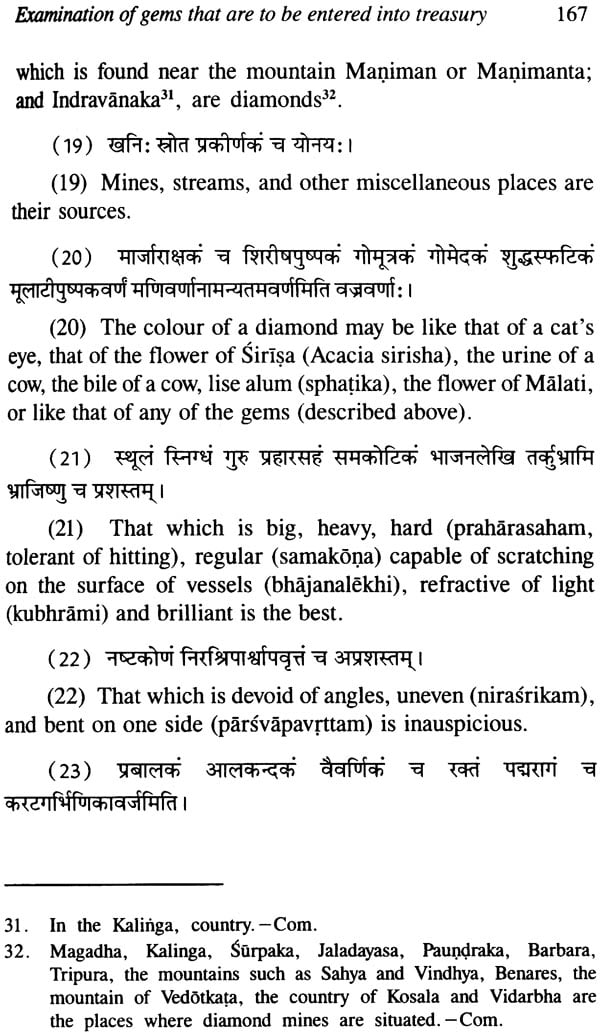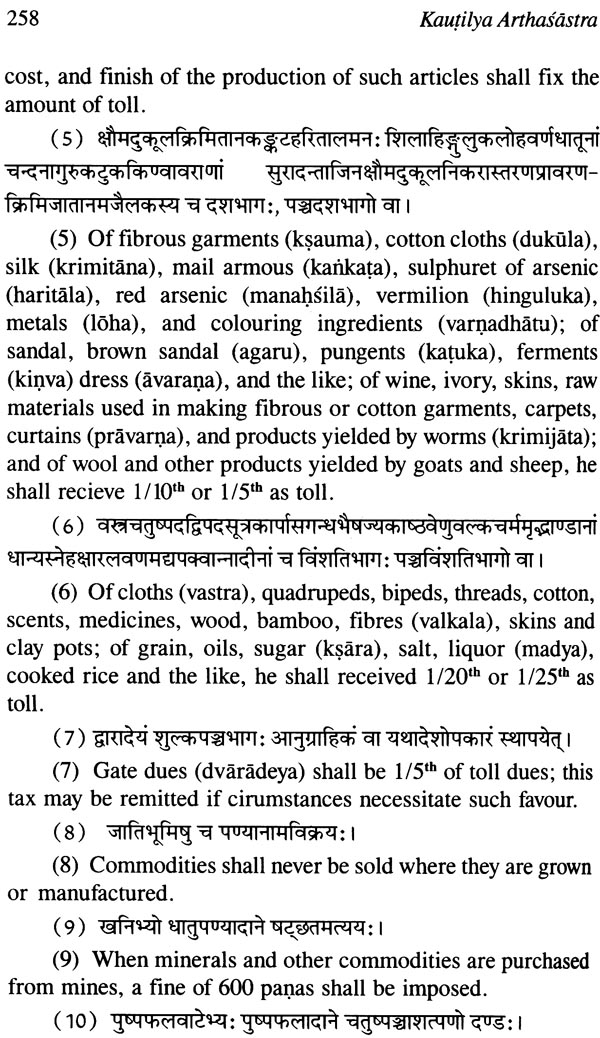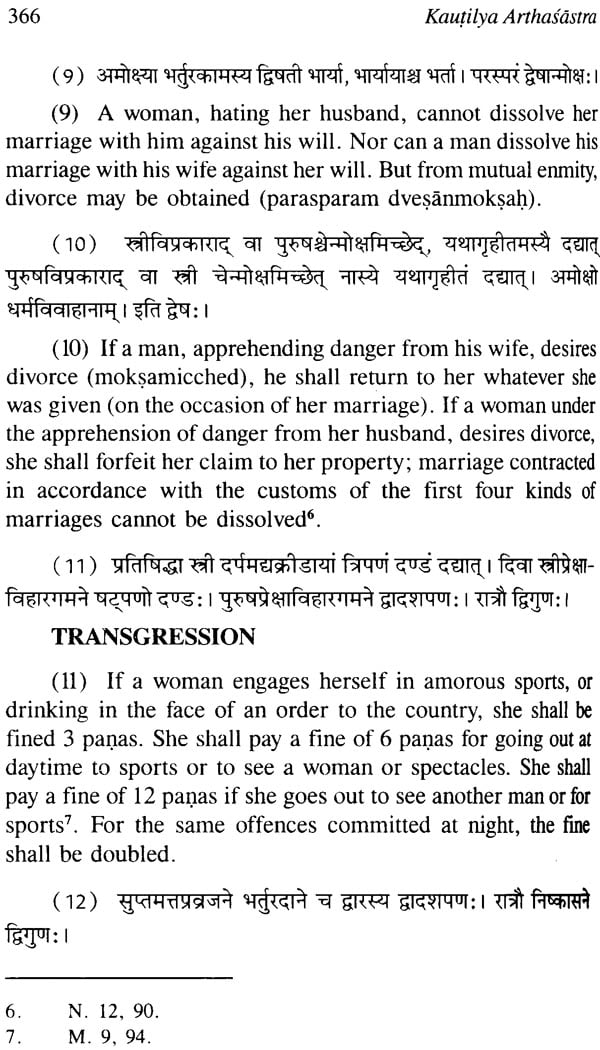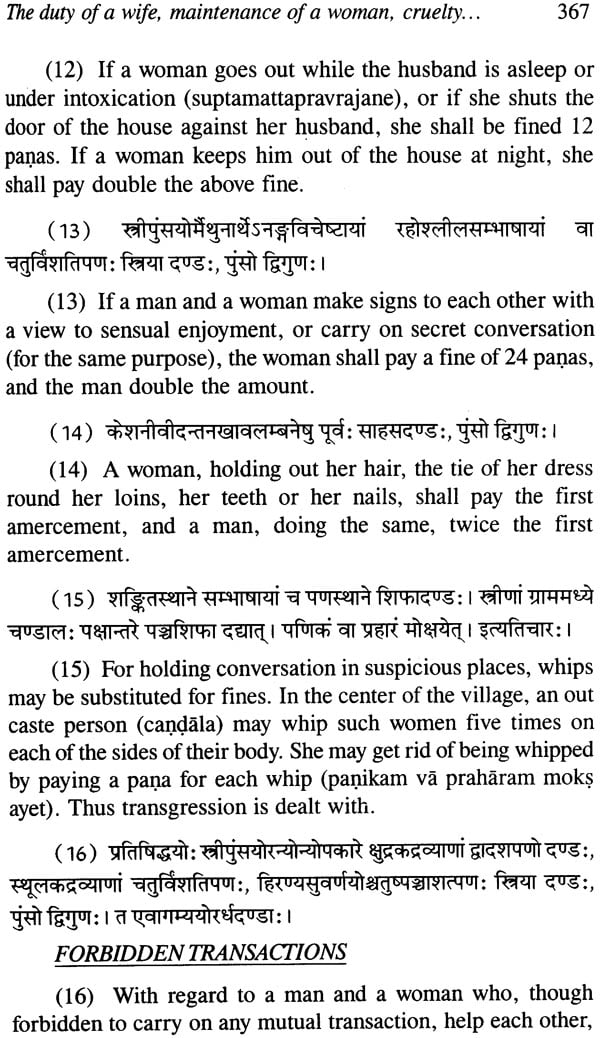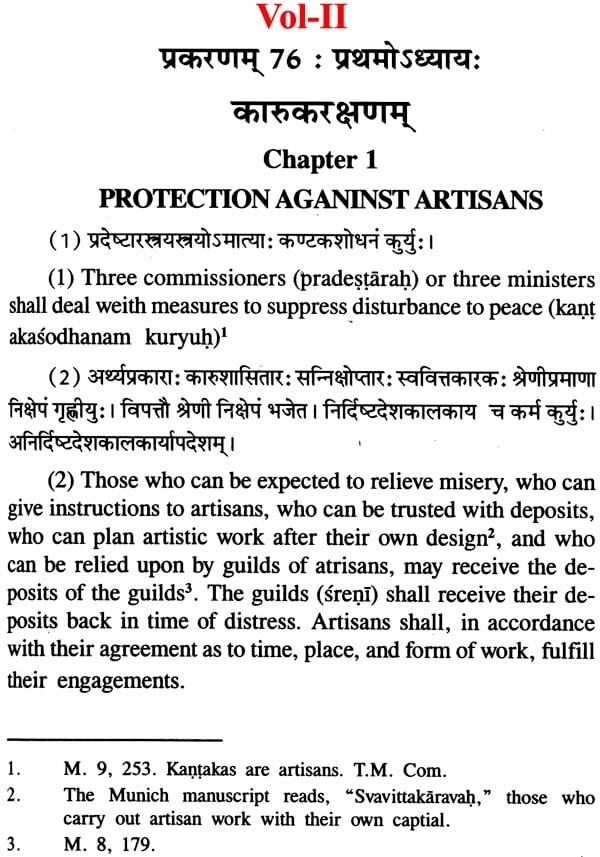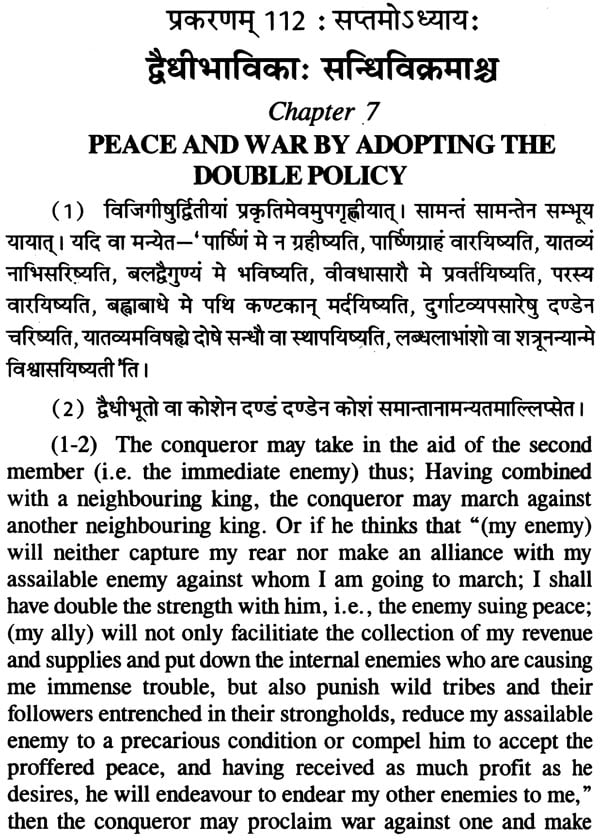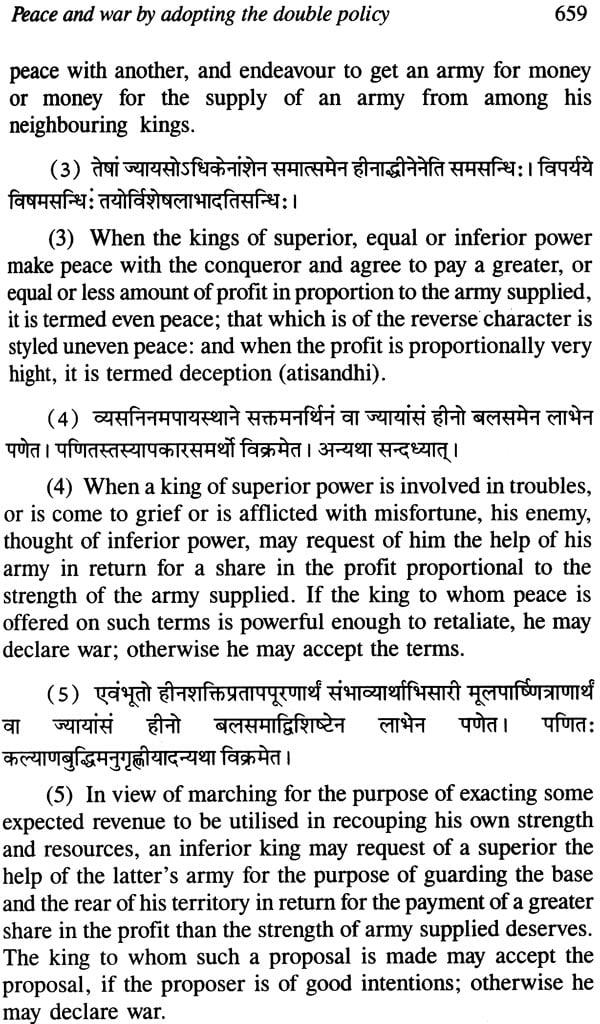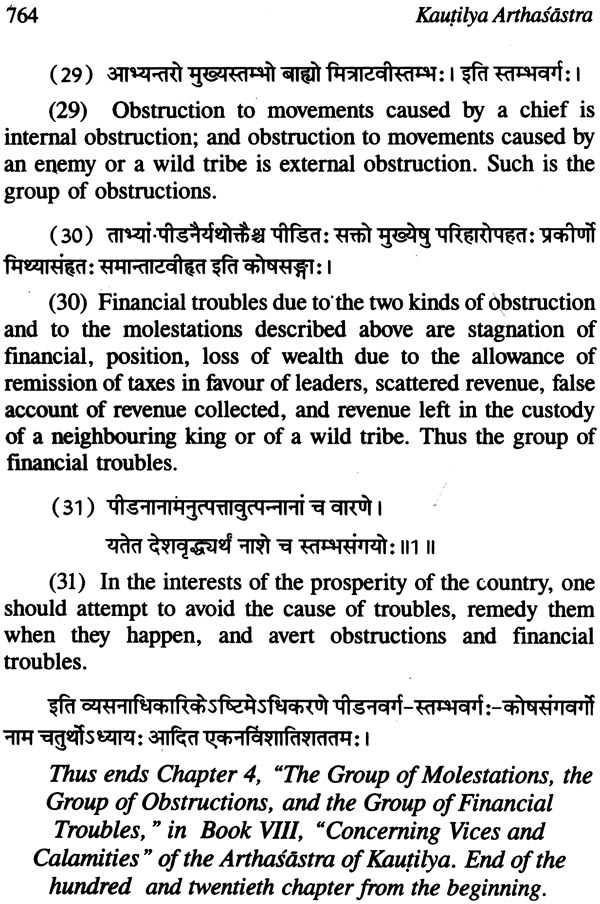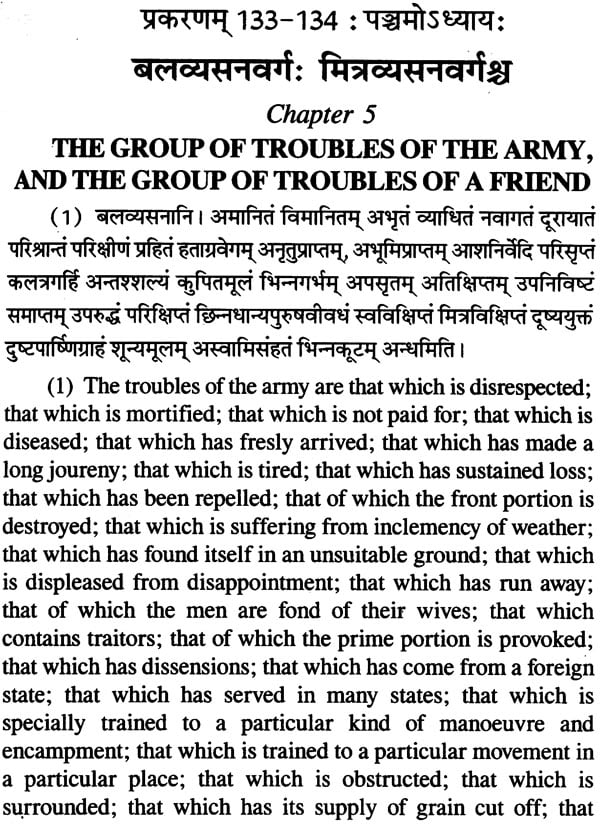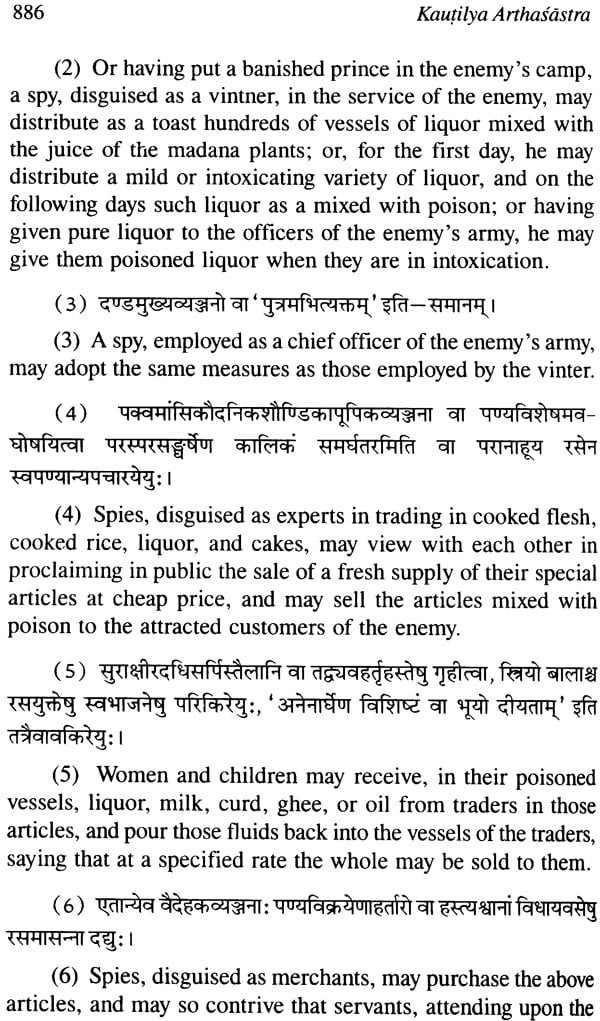
Kautilya's Arthasastra (Set of 2 Volumes)
Book Specification
| Item Code: | NAP908 |
| Author: | Rudrapatna Samasastri Edited by Dr. Ashok Kumar Shukla |
| Publisher: | Parimal Publication Pvt. Ltd. |
| Language: | Sanskrit Text with English Translations |
| Edition: | 2019 |
| ISBN: | 9788171106417 |
| Pages: | 1030 |
| Cover: | Hardcover |
| Other Details | 9.0 inch x 6.0 inch |
| Weight | 1.40 kg |
Book Description
The Arthasastra summarizes the political thoughts of Kautilya. The book contains detailed information about specific topics that are relevant for rulers who wish to run an effective government. Diplomacy and war (including military tactics) are the two points treated in most detail but the work also includes recommendations on law, prisons, taxation, irrigation, agriculture, mining, fortifications, coinage, manufacturing, trade, administrations, diplomacy, and spies.
The Arthasastra explores issues of social welfare, the collective ethics that hold a society together, advising the king that in times and in areas devastated by famine, epidemic and such acts of nature, or by war, he should initiate public projects such as creating irrigation waterways and building forts around major strategic holdings and towns and exempt taxes on those affected. The text was influential on other Hindu texts that followed, such as the sections on king, governance and legal procedures included in Manusmrti.
Likely to be the work of several authors over centuries, Kautilya, also identified as Visnugupta and Canakya, is traditionally credited as the author of the text. The Arthasastra was influential until the 12th century, when it disappeared. It was rediscovered in 1905 by R. Samasastri, who published it in 1909. The first English translation was published in 1915.
The present book contains Original Sanskrit text, verse by verse English translation and notes of R. Samasasti along with an exhaustive Introduction by Dr. Ashok Kumar Shukla.
Foreword
The Kautilya-Arthasastra, of which Mr. Samasastri gives us here his translation, is a work of exceptional interest and value. In the first place, it ascribes itself in unmistakable terms to the famous Brahmin Kautilya, also named Visnugupta and known from other sources by the patronymic Canakya who tradition tells us, overthrew the last king of the N anda dynasty, and placed the great Maurya Candragupta on the throne: thus, the two verses with which the work ends recite that it was written by Visnugupta, who from intolerance of misrule rescued the scriptures, the science of weapons, and the earth which had passed to Nanda King and that he wrote it because he had seen many discrepancies on the part of previous commentators; and, in conformity with a common practice of Indian writers the name Kautilya figures constantly through the book, especially in places where the author lays down his own views as differing from others which he cites. The work accordingly claims to date from the period 321-296 B.C.: and its archaic style is well in agreement with the claim. Secondly, as regard its nature and value, Kautilya is renowned, not only as a kingmaker, but also for being the greatest Indian exponent of the art of government, the duties of kings, ministers and officials, and the methods of diplomacy. That a work dealing with such matters was written by him is testified to by various more or less early Indian writers, who have given quotations from it. But the work itself remained hidden from modem eyes until it was found in the text of which this is the translation. The topic of this text is precisely that which has been indicated above, in all its branches, internal and foreign, civil, military, commercial, fiscal, judicial and so on including even tables of weights, measures of length and divisions of time. And it seems to be agreed to by competent judges that, though the existing text is, perhaps, not absolutely word for word that which was written by Kautilya, still we have essentially a work that he did compose in the period stated above. The value of it is unmistakable: it not only endorses and extends much of what we learn in some of its lines from the Greek writer Megasthenes, who, as is well known, spent a long time in India as the representative of the Syrian king, Seleucus I at the Court of Candragupta, but also fills out what we gather from the epics, from other early writings, and from the inscriptions, and explains statements and allusions in those last-mentioned sources of information which are otherwise obscure: in short, it throws quite a flood of light on many problems in the branch of Indian studies to which it belongs.
For our introduction to this work we are greatly indebted to Mr. Samasastri. A manuscript of the text, and with it one of commentary on a small part of it by a writer named Bhattasvamin, was handed over by a Pandita of the Tanjore District to the Mysore Government Oriental Library. From these materials Mr. Samasastrt, who was then the Librarian of that Library, gave a tentative translation in the pages of the Indian Antiquary and elsewhere, in 1905 and following years. By the enlightened encouragement of the Mysore Durbar, he was enabled to publish the text itself in 1909, as Vol. 37 of the Biblothecea Sanskrita of Mysore. And under the same appreciative patronage he now lays before us a translation which has been improved in various details, in addition to being brought together in a connected and convenient form. His task has been no easy one. For the formation of his text, as for this translation of it, he has had only the one manuscript and the partial commentary which have been mentioned above: and the text is by no means a simple one: it is laconic and difficult to a degree. In these circumstances, it could hardly be the case that anyone should be able to give us a final treatment of the work straightaway. It seems that as a result of the attention which Mr. Samasastri's labours attracted at once, two or three other manuscripts of the work have now been traced. So it may be hoped that eventually another step may be made, by giving us a revised text, based on a collation of materials, which will remove certain obscurities that still exist. Meanwhile, it is impossible to speak in too - high terms of the service rendered by Mr. Samasastri, in the first place by practically discovering the work, and then by laying the contents of it before us so satisfactorily, in spite of the difficulties confronting him, which can only be appreciated by anyone who tries to understand the text without the help of his translation. We are, and shall always remain, under a great obligation to him for a most important addition to our means of studying the general history of ancient India.

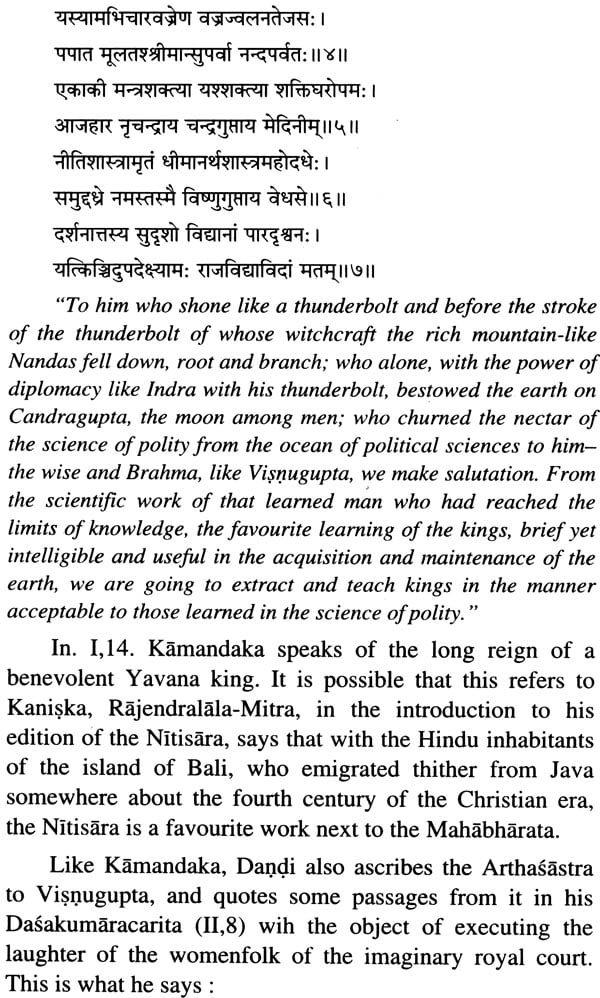

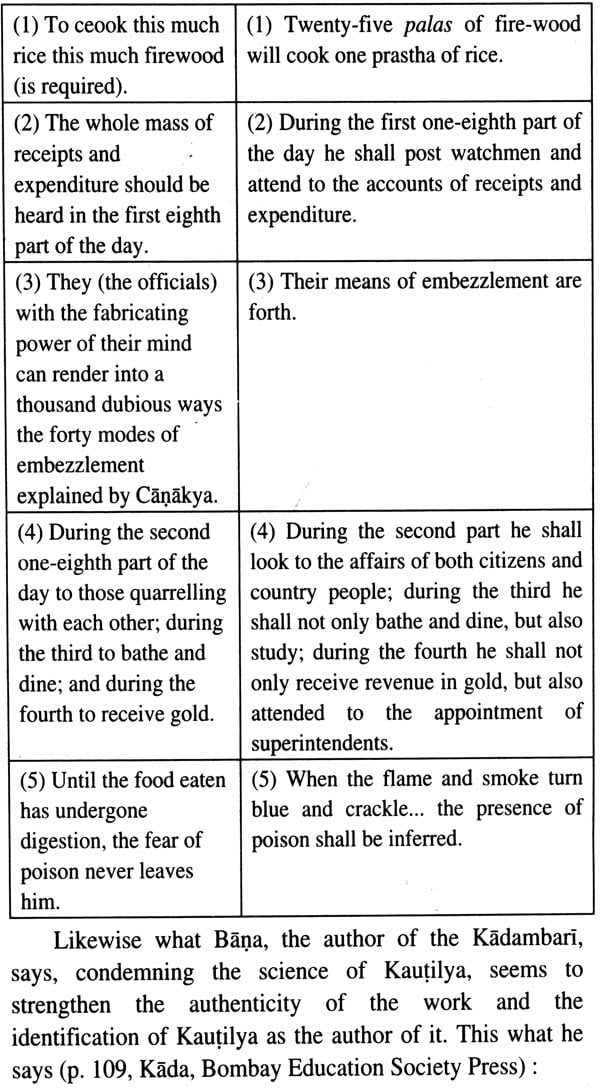
Contents
| Foreword | v | |
| Preface | ix | |
| Introduction | xxvii | |
| Book I : Concerning Discipline | 1-94 | |
| 1 | The Life of a King | 1 |
| 2 | Determination of the Place of Anvik~aki | 10 |
| 3 | Determinations of the Place of Triple Vedas | 13 |
| 4 | Vam and Dandaniti | 16 |
| 5 | Association with the Aged | 19 |
| 6 | The sharing off of the Aggregate of the Six Enemies | 22 |
| 7 | The life of a Saintly King , | 25 |
| 8 | Creation of Ministers | 27 |
| 9 | The creation of Councilors and Priests | 31 |
| 10 | Ascertaining by Temptations, Purity or Impurity in the Character of Ministers | 34 |
| 11 | The Institution of Spies | 39 |
| 12 | Creation of Wandering Spies | 43 |
| 13 | Protection of Parties for or against one's own cause in one's Own State | 49 |
| 14 | Winning over factions for or against an Enemy's Cause in an Enemy's State | 53 |
| 15 | The Business of Council Meeting | 58 |
| 16 | The Mission of envoys | 65 |
| 17 | Protection of Princes | 70 |
| 18 | The conduct of a Prince kept Under Restraint and the Treatment of a Restrained Prince | 76 |
| 19 | The duties of a king | 79 |
| 20 | Duty towards the harem | 84 |
| 21 | Personal Safety | 89 |
| Book II : The Duties of Government Superintendents | ||
| 1 | Formation of Villages | 97 |
| 2 | Division of Land | 104 |
| 3 | Consturction of Forts | 108 |
| 4 | Building within the Fort | 114 |
| 5 | The Duties of the Chamberlain | 119 |
| 6 | The Business of Collection of Revenue by the Collector-General | 124 |
| 7 | The Business of keeping up Accounts in the Office of Accountants | 131 |
| 8 | Detection of what is Embezzled by Government Servants out of State Revenue | 138 |
| 9 | Examination of the conduct of government servant | 145 |
| 10 | The procedure of forming Royal writs | 151 |
| 11 | Examination of Gems that are to be entered into treasury | 161 |
| 12 | Conducting Mining Operations and Manufacture | 177 |
| 13 | The Superintendent of Gold in the Goldsmiths' office | 188 |
| 14 | The Duties of the State Goldsmith in the high Road | 198 |
| 15 | The Superintendent of Store-House | 207 |
| 16 | The Superintendent of Commerce | 218 |
| 17 | The Superintendent of Forest produce | 223 |
| 18 | The Superintendent of the Armoury | 228 |
| 19 | The Superintendent of Weights and Measures | 235 |
| 20 | Measurement of Space and Time | 243 |
| 21 | The Superintendent of Tolls | 251 |
| 22 | Regulation of Toll-Dues | 257 |
| 23 | The Superintendent of Weaving | 260 |
| 24 | The Superintendent of Agriculture | 264 |
| 25 | The Superintdent of Liquor | 272 |
| 26 | The Superintendent of Slaughter-House | 280 |
| 27 | The Superintendent of Prostitutes | 283 |
| 28 | The Superintendent of Ships | 290 |
| 29 | The Superintendent of Cows | 296 |
| 30 | The Superintendent of Horses | 304 |
| 31 | The Superintendent of Elephants | 313 |
| 32 | The training of Elephants | 318 |
| 33 | The Superintendent of Chariots; the Superintendent of infantry and the Duties of the Commander-in- Chief | 323 |
| 34 | The Superintendent of passports and the Super- intendent of Pasture Lands | 327 |
| 35 | The Duty of Revenue-Collectors; Spies under the guise of Householders, Merchants and Ascetics | 329 |
| 36 | The Duty of a City Superintendent | 334 |
| Book III : Concerning Law | ||
| 1 | Determination of Forms of agreement; Determination of legal disputes | 345 |
| 2 | The duty of marriage, the property of a woman, and compensation for re-marriage | 355 |
| 3 | The Duty of a wife, maintenance of a Woman, Cruelty to Women, enmity between Husband andWife; a Wife's Transgression; her kindness to another, and forbidden Trasactions | 363 |
| 4 | Vagrancy, Elopement and short and long Sojournments | 369 |
| 5 | Procedure of portioning inheritance | 376 |
| 6 | Special shares in inheritance | 382 |
| 7 | Distinction between sons Buildings | 387 |
| 8 | House-Building | 392 |
| 9 | Sale of Buildings, Boundary Disputes, Determination of Boundaries, and Miscellaneous Hinderances | 397 |
| 10 | Destruction of Pasture Lands, fields and roads, and non-performance of Agreements | 404 |
| 11 | Recovery of Debts | 412 |
| 12 | Concerning Deposits | 421 |
| 13 | Rules regarding Slaves and Labourers | 430 |
| 14 | Rules Regarding Labourers and Cooperative Undertaking | 437 |
| 15 | Rescisssion of Purchase and Sale | 443 |
| 16 | Resumption of Gifts, Sale without Ownership, and Ownership | 447 |
| 17 | Robbery | 454 |
| 18 | Defamation | 457 |
| 19 | Assault | 461 |
| 20 | Gambling and Betting And Miscellaneous offences | 468 |
| Book IV : Removal of Thorns | ||
| 1 | Protection against Artisans | 475 |
| 2 | Protection against Merchants | 485 |
| 3 | Remedies against National Calamities | 491 |
| 4 | Suppression of the Wicked Living by Foul Means | 498 |
| 5 | Detection of Youths of Criminal Tendency by Ascetic Spies | 502 |
| 6 | Seizure of Criminals on suspicion or in the very Act 506 | 513 |
| 7 | Examination of Sudden Death | 519 |
| 8 | Trial and Torture to Elicit Confession | 525 |
| 9 | Protection of all kinds of Government Departments | 533 |
| 10 | Fines in Lieu of Multilation of Limbs | 538 |
| 11 | Death with or without Torture | 543 |
| 12 | Sexual Intercourse with Immature Girls n Punishment for Violating Justice | 550 |
| Book V : Conduct of Courtiers | ||
| 1 | Concerning the awards of Punishment | 559 |
| 2 | Replenishment of the Treasury | 568 |
| 3 | Concerning subsistence to Government Servants | 578 |
| 4 | The Conduct of a Courtier | 585 |
| 5 | Time-serving | 589 |
| 6 | Consolidation of the Kingdom and Absolute Sovereignty | 594 |
| Book VI : The Source of Sovereign States | ||
| 1 | The Elements of Sovereignty | 603 |
| 2 | Concerning Peace and Exertion | 608 |
| Book VII : The End of Six-Fold Policy | ||
| 1 | The Six-Fold Policy, and Determination of Deterioration, Stagnation and Progress | 617 |
| 2 | The Nature of Alliance | 624 |
| 3 | The Character of Equal, Inferior and Superior Kings; and Forms of Agreement made by an Inferior King | 628 |
| 4 | Neutrality after Proclaiming war or after concluding a treaty of Peace; Marching after Proclaiming war or after making Peace; and the march of combined Powers | 635 |
| 5 | Consideration about Marching against an Assailable Snemy and a Strong Enemy; causes leading to the Dwindling, Greed, and Disloyalty of the Army; and Considerations about the Combination of Powers | 641 |
| 6 | The march of Combined Powers; Agreement of Peace with or without definite terms; and Peace with Renegades | 649 |
| 7 | Peace and war by Adopting the Double Policy | 668 |
| 8 | The attitude of an Assailable agreement Enemy and Friends that Deserve help | 664 |
| 9 | Agreement for the Acquistion of a Friend or Gold | 670 |
| 10 | Agreement of Peace for the Acquisition of Land | 678 |
| 11 | Interminable Agreement | 682 |
| 12 | Agreement for undertaking a work | 689 |
| 13 | Considerations about an Enemy in the Rear | 695 |
| 14 | Recruitment of Lost Power | 703 |
| 15 | Measures Conducive to Peace with a Strong and Provoked Enemy; and the Attitude of a Conquered Enemy | 709 |
| 16 | The attitude of a Conquered King | 715 |
| 17 | Making Peace and breaking it | 720 |
| 18 | The Conduct of a Madhyama King, a Neutral King, and of a Circle of States | |
| Book VIII: Concerning Vices and Valamities | ||
| 1 | The Aggregate of the Calamities of the Elements of Sovereignty | 739 |
| 2 | Considerations about the Troubles of the King and of his Kingdom | 746 |
| 3 | The aggregate of the Troubles of Men | 750 |
| 4 | The group of Molestations, the Group of Obstructions, and the group of Financial Troubles | 757 |
| 5 | The Group of Troubles of the Army, and the Group of Troubles of a Friend | 765 |
| Book IX : The Work of an Invader | ||
| 1 | The Knowledge of Power, Place, Time, Strength, and Weakness; the Time of Invasion | 775 |
| 2 | The Time of recruiting the Army; the form of equipment; and the work of Arraying a Rival Force | 782 |
| 3 | Consideration of Annoyance in the Rear; and remedies against internal and External Troubles | 789 |
| 4 | Consideration about Loss of Men, Wealth, and Profit 796 | |
| 5 | External and Internal Dangers | 801 |
| 6 | Persons Associated with Traitors and Enemies | 805 |
| 7 | Doubts about Wealth and Harm; and Success to be Ebtained by the Employment of Alternative Strategic means | 813 |
| Book X : Relating to War | ||
| 1 | Encampment | 827 |
| 2 | March of the Camp and Protection of the Army in Times of Distress and Attack | 830 |
| 3 | Forms of Treacherous Fights, Encouragement to one's own Army and Fight between One's Own and Enemy's Armies | 834 |
| 4 | Battlefields: the work of Infantry, Cavalry, Chariots and Elephants | 842 |
| 5 | The Distinctive Array of Troops in respect of wings, Flanks and Front; distinction between Strong and Weak Troops; and Battle with Infantry, Cavalry, Chariots and Elephants | 846 |
| 6 | The Array of the Army like a Staff, a Snake, a Circle, or in Detached order; the array of the Army against that of an Enemy | 853 |
| Book XI : The Conduct of Corporations | ||
| 1 | Causes of dissension; and Secret Punishment | 861 |
| Book XII : Concerning a Powerful Enemy | ||
| 1 | The Duties of a Messenger | 871 |
| 2 | Battle of Intrigue | 875 |
| 3 | Slaying the Commander-in-Chief and Inciting a Circle of States | 881 |
| 4 | Spies with Weapons, Fire and Poison; and Destruction of supply Stores and Granaries | 885 |
| 5 | Capture of the Enemy by means of secret Contrivances or by means of the Army; and Complete Victory | 890 |
| Book XIII: Strategic Means to Capture Fortress | ||
| 1 | Sowing the Seeds of Dissension | 899 |
| 2 | Enticementof Kings by Secret Contrivances | 904 |
| 3 | The work of Spies in a Siege | 912 |
| 4 | The Operation of a Siege and Storming a Fort | 919 |
| 5 | Restoration of Peace in a Conquered Country | 929 |
| Book XIV : Secret Means | ||
| 1 | Means to Injure an Enemy | 935 |
| 2 | Wonderful and Delusive Contrivances | 944 |
| 3 | The Application of Medicines and Mantras | 953 |
| 4 | Remedies against the Injuries of One's Own Army | 965 |
| Book XV : The Plan of a Treatise | ||
| 1 | Paragraphical divisions of the treatise Index | 971 |
